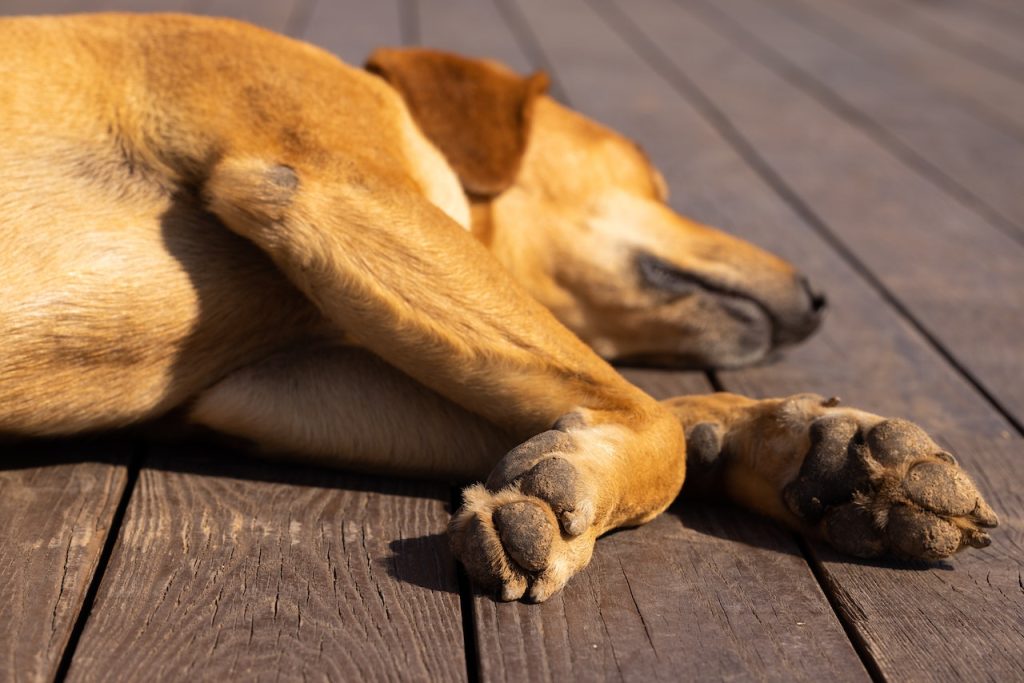As a responsible dog owner, you’re likely already attuned to your furry companion’s well-being. But have you ever considered the importance of taking care of your dog’s paws? These unsung heroes endure a lot, and it’s vital to ensure they stay healthy and comfortable. In this guide, we’ll explore the world of paw care, from recognizing common issues to offering expert advice and tips.

Why Paw Care Matters
Paw care matters significantly for dogs, as their paws are their foundation for everything they do. Regular paw maintenance, including inspections, cleaning, and nail trimming, is essential for preventing discomfort, injuries, and infections. It plays a crucial role in ensuring that your canine friend stays happy, active, and healthy. Keep reading to find out how taking care of your dog’s paws consistently can help reduce related health issues.
Common Paw Problems
Cracked Pads
Cracked paw pads can be a common issue in dogs, often caused by environmental factors like hot pavements or cold, dry conditions. These cracks can lead to pain and discomfort for your furry companion. Proper paw care, including moisturizing and protective measures, is essential to prevent and address cracked pads, ensuring your dog’s paws remain healthy and pain-free.
Ingrown Nails
Ingrown nails in dogs can be a painful condition where the nail grows into the flesh of the paw. This can lead to inflammation, infection, and lameness. It’s essential to keep an eye on your dog’s nails and trim them regularly to prevent ingrown nails. If you notice signs of an ingrown nail, such as limping, swelling, or redness, consult your veterinarian for proper care. They may need to trim the nail and treat any infection, ensuring your dog’s paws remain comfortable and healthy.
Bacterial Infections
Bacterial infections in dogs can affect various parts of their bodies, including the skin, ears, and paws. These infections often result from the overgrowth of harmful bacteria and can cause symptoms like redness, swelling, itching, and discharge. Proper paw care and hygiene are crucial in preventing bacterial infections in your dog’s paws. Regular paw inspections, cleaning, and keeping their paws dry can go a long way in reducing the risk of such infections. If you suspect a bacterial infection, consult your veterinarian for a proper diagnosis and treatment plan to ensure your dog’s paws stay healthy and free from discomfort.
Regular Paw Inspections
Regular paw inspections are a fundamental part of responsible pet ownership. Therefore, by routinely checking your dog’s paws, you can identify issues early, such as cuts, debris, or signs of infection. This proactive approach to paw care ensures that your furry friend’s paws remain healthy and comfortable, promoting their overall well-being.
Proper Paw Cleaning
Proper paw cleaning is an essential aspect of dog grooming and hygiene. To keep your dog’s paws healthy and free from dirt and potential irritants, follow these steps:
- Prepare a basin of warm water with mild dog-friendly shampoo.
- Gently dip each paw into the soapy water and let it soak for a minute.
- Use a soft brush or toothbrush to scrub between the paw pads and toes, removing dirt and debris.
- Rinse the paw thoroughly with clean, warm water to eliminate any soap residue.
- Pat the paw dry with a towel, ensuring it’s completely dry to prevent bacterial growth.
- Repeat this process for all paws, making it a positive and gentle experience for your dog.
Regular paw cleaning helps maintain your dog’s comfort and hygiene, preventing potential issues.
Moisturizing Your Dog’s Paws
Moisturizing your dog’s paws is an essential part of paw care, especially in dry or harsh weather conditions. To keep their paw pads soft and supple:
- Use a dog-specific paw balm or moisturizer, as human products may contain ingredients harmful to dogs.
- Apply a small amount to each paw pad, massaging it in gently.
- Pay special attention to areas that may be prone to dryness, such as the elbow calluses and in between the toes.
- Use paw balm after walks in hot or cold weather to help protect against extreme conditions.
- Moisturizing can help prevent painful cracks and provide overall comfort for your furry friend.
Consult with your veterinarian for recommendations on the best paw care products for your specific dog, as different breeds and individual dogs may have unique needs.
Trimming Your Dog’s Nails
Trimming your dog’s nails is a crucial aspect of paw care to maintain their comfort and overall health. Here are the steps to properly trim your dog’s nails:
- Gather Supplies: Get a pair of dog-specific nail clippers or a grinder, as well as a styptic powder in case you accidentally cut the quick (the sensitive part of the nail).
- Comfort and Familiarity: Ensure your dog is comfortable with the process. Familiarize them with the clippers and the sensation of having their paws handled.
- Choose a Well-Lit Area: Pick a well-lit, quiet space for the task.
- Positioning: Hold your dog’s paw firmly but gently. Identify the quick – the pink part inside the nail – and avoid cutting it.
- Trimming: Make small, gradual cuts to avoid cutting the quick. If using a grinder, gently grind the nails. Pay attention to the front and back nails.
- Praise and Reward: Offer praise and treats during and after the process to create a positive association.
- Regularity: Trim your dog’s nails every 2-4 weeks, or when you hear them clicking on the floor.
- Professional Help: If you’re unsure or uncomfortable with nail trimming, consult a professional dog groomer or veterinarian.
Proper nail maintenance is vital to prevent discomfort, injury, and complications in your dog’s paws.

Paw Protection in Extreme Weather
Paw protection in extreme weather is crucial to keep your dog comfortable and safe. In hot weather, protect their paws from scorching pavement by walking during cooler times of the day or using protective booties. In cold weather, ice and salt can be harsh on their feet, so consider using booties to shield their paws from these elements. Always inspect their paws after walks to remove any ice or salt. Being mindful of extreme weather conditions and taking steps to protect your dog’s paws will ensure they remain healthy and pain-free in any climate.
When to Consult a Veterinarian
Consulting a veterinarian for paw-related concerns is essential when:
- Infection Signs: If you notice signs of infection, such as redness, swelling, discharge, or a foul odor in your dog’s paws.
- Persistent Limping: If your dog continues to limp or favor a paw for an extended period, indicating pain or discomfort.
- Injury: In cases of visible injuries, deep cuts, or puncture wounds on the paw, which may require stitches or medical attention.
- Ingrown Nails: When your dog has an ingrown nail or a painful nail issue.
- Chronic Issues: If your dog has chronic paw problems, such as recurring infections, cysts, or growths.
- Change in Behavior: When your dog’s behavior changes due to paw discomfort, indicating a potential issue.
- Excessive Licking: If your dog excessively licks or chews at their paws, which could lead to irritation or infection.
- Allergic Reactions: In the case of allergic reactions that cause paw swelling, redness, or hives.
- Severe Cracking or Dryness: When your dog’s paw pads become excessively dry or severely cracked, causing pain.
If you observe any of these signs or have concerns about your dog’s paw health, it’s wise to consult your veterinarian promptly. Early intervention can prevent complications and ensure your dog’s paws remain comfortable and healthy.
FAQs About Paw Care
Here are some common questions about taking care of your dog’s paws:
- Can I use human moisturizers on my dog’s paws? While it may be tempting to use human moisturizers on your dog’s paws, it’s generally not recommended. The skin on your dog’s paws is different from human skin, and some moisturizers designed for humans may contain ingredients that can be harmful to dogs.
- How often should I trim my dog’s nails? The frequency of trimming your dog’s nails can vary depending on the breed, activity level, and individual characteristics of your dog. As a general guideline, most dogs benefit from nail trims every 2 to 4 weeks.
- What signs indicate a paw infection? Some symptoms of a paw infection include: limping, swelling, redness, excessive licking, discharge or pus, and a paw that is warm to the touch. It’s best to consult a veterinarian if you believe your dog may have an infection.
Cleaning Questions
- Is there a specific way to clean between my dog’s paw pads? Cleaning between your dog’s paw pads is a simple but crucial part of paw care. Begin by preparing a warm, soapy solution using mild dog-friendly shampoo. Gently dip your dog’s paw into the warm water and let it soak for a minute or two to soften any dirt or debris. Then, using a soft brush or toothbrush, delicately scrub between the paw pads and toes. Rinse the paw thoroughly with clean, warm water to remove any soap residue. After rinsing, pat the paw dry with a clean towel, making sure to remove all moisture. Repeat this process for all of your dog’s paws.
- Are there any breeds with unique paw care needs? Paw care can vary across dog breeds due to differences in paw structure, activity levels, and coat types. Some breeds may require more attention to prevent matting or ice accumulation between their paw pads, while others with flat faces may need special care to alleviate paw pressure. Understanding these breed-specific needs is key to ensuring the overall health and comfort of your furry companion. Consulting with professionals can provide tailored guidance for effective paw care.

By understanding common paw problems, practicing regular paw care, and following our expert tips, you can ensure you’re taking care of your dog’s paws properly so they remain healthy and comfortable for years to come.
Read more blog posts!



